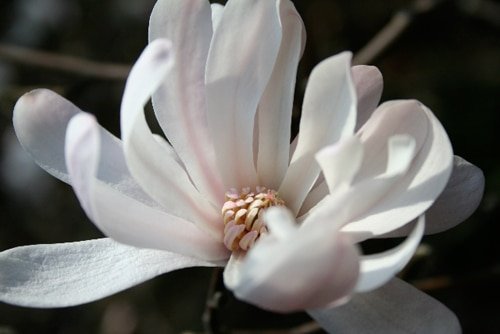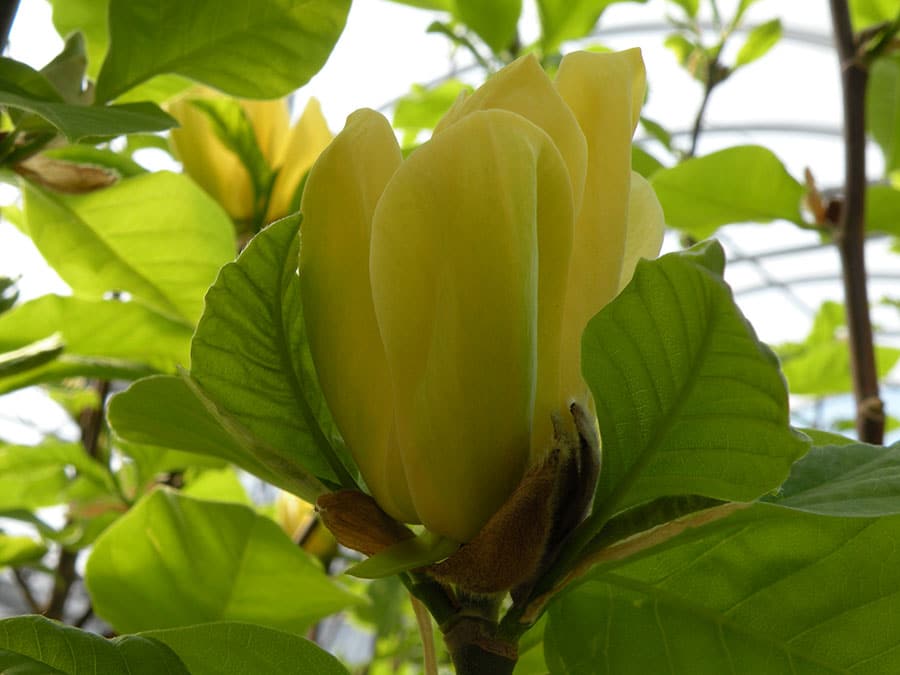
Creamy magnolia blossoms in the crisp spring air are the fulfillment of a gardener’s winter dream. But their alluring scent exceeds our expectations of what these lovely trees offer. I learned this on a trip to Washington, D.C., where I came upon a mature specimen of Magnolia grandiflora, the great bull bay or evergreen southern magnolia. It is a prominent member of the family Magnoliaceae, trees of antiquity found in fossil remains of the tertiary period, after the demise of non-avian dinosaurs. Full 60 feet (18 m) tall and nearly as wide, the tree with its thousands of creamy white blooms was impressive. However, it was the warm aromatic cloud of spicy lemon-verbena that gave me a new appreciation of the perfume this genus can produce. Every Canadian-grown magnolia is graced with beautiful flowers — but are some as scented as their southern cousins, and do they retain their fragrance in a cool northern spring?
Native to eastern Asia and eastern North America, magnolias are generous with their elegant blossoms and are ornamental through four seasons, with distinctive green foliage in summer, dangling orange-red seeds in autumn and furry silver bud coverings (called perules) through winter. Magnolia petals are referred to as tepals — a primitive combination of petals and sepals — and their thick substance is a repository of many chemical scent compounds, most frequently containing citrus-scented linalool, a naturally occurring terpene alcohol. A northern gardener emerging desperate and distraught from long weeks of winter looks upon a blossom-laden magnolia with a sense of salvation, and may entirely forget to breathe. But all magnolias — including those we grow in Canada’s Zones 5 and 6 — have sufficient scent able to satisfy even rosarians accustomed to waiting longer for their perfumed passions.
The release of scent from magnolia tepals is influenced by time of day or night, air temperature and humidity. Its character, or flavour, depends on the mix of compounds in each flower, often with a lemony linalool base. Consequently, magnolias can smell like sweet candy, spicy verbena, tart lemon, citrus-honey or dusty violets. The temperature and humidity in your garden determine when tepals release their scent in greatest intensity. In my own garden, for example, the scent is released in the cool morning air when the tepals are fully hydrated, and again in late afternoon when direct sunlight passes away from the flowers. A quick sniff of magnolia flowers at any time is sure to reveal a pleasing fragrance; a few blooms in water perfume a room.
Most common in our gardens is the beautiful saucer magnolia, M. x soulangeana (19 ft x 10 ft/6 m x 3 m), which has large chalice-form flowers that vary from white to pink to purple, demonstrating the variability of tepal colour when grown from seed. Complaints have been made about the inevitable task of collecting the fallen tepals from these gorgeous flowers. Gentle reader, I can only say it is a privilege to sweep the lawn under such a magnificent tree.
Of the soulangeana hybrids, ‘Alexandrina’ (26 ft x 26 ft/8 m x 8 m) is flushed rose-purple on the outside, with pure white on the interior of the tepals. It is one of the largest specimens, with a moderately sweet scent. ‘Forrest’s Pink’ (33 ft x 33 ft/10 m x 10 m) has deep pink broad tepals forming a more rounded flower, with an intense, candy-violet scent.
For narrow spaces or a symmetrical lawn specimen, ‘Galaxy’ (M. x ‘Galaxy’, 33 ft x 20 ft/10 m x 6 m) carries profuse large deep red-purple flowers with a moderately sweet scent. Perfect for backyards are the M. x loebneri hybrids, with flowers formed from tassels of 15 to 17 narrow strappy tepals. Flowers of ‘Merrill’ (33 ft x 20 ft/10 m x 6 m) are pure milk white on an upright, rounded tree. The flowers of ‘Leonard Messell’ (13 ft x 20 ft/4 m x 6 m) are flushed with a pink line along their centre and fuchsia-pink on the back of the tepals. They make a bright, striking show, and give off a lemony perfume. ‘Ballerina’ (20 ft x 20 ft/6 m x 6 m) is intensely fragrant, with a sweet candy scent and large white flowers (up to 30 strappy tepals) with pinkish-hued centres.
Small pocket gardens and urban front lawns are ideal for the colourful shrub-form “little girl” hybrids — crosses between M. liliiflora ‘Nigra’ (deep purple) and the beautiful species hybrid M. stellata ‘Rosea’ (diminutive size, strong scent). M. x ‘Susan’ (8 ft x 8 ft/2.5 m x 2.5 m) has red-purple flowers with slightly twisted tepals; the flowers of ‘Betty’ (10 ft x 8 ft/3 m x 2.5 m) have white interiors with purple-pink outside; and ‘Ricki’ (16 ft x 7 ft/5 m x 2 m) is deep purple with white flushes on the interior. All the girls have scent from their M. stellata parent.
Planting and caring for magnolias
Magnolias are easy to grow in full sun or part shade and make few demands once established. Plant them in well-draining soil enriched with generous amounts of leaf litter, compost and peat moss. Magnolias don’t like to be planted too deeply; make the planting hole just deep enough to accommodate the root ball without burying any of the trunk. They require consistent moisture and rely on regular irrigation, particularly in the heat and drying winds of summer. Mulch with a four-inch (10-cm) layer of shredded bark to keep the soil cool and moist.
Magnolias seldom require feeding or pruning. They are occasionally susceptible to bark scale insects, which can seriously damage them. Spray with dormant oil in autumn, after leaf drop, to prevent or control scale without harming flower buds. Choose a bright day without wind or rain, when temperatures remain between 5 and 15° C, and follow manufacturer’s directions. Spray limbs and trunks, covering all exposed bark areas. Dormant oil smothers any scales present, and you can look forward to a sweet-smelling spring.

Five magnolias for fragrance
No. 1
M. ‘Elizabeth’, Zone 5, has primrose-yellow buds, opening to transparent creamy yellow flowers. One of a dozen recently introduced yellow scented magnolia hybrids of M. acuminata, the cucumbertree magnolia. ‘Butterflies’ has medium-yellow flowers with contrasting red stamens, and holds its colour without fading to cream.
No. 2
The many M. x loebneri cultivars all have varying degrees of fragrance. Loebner magnolias began with a cross between M. kobus and M. stellata. Zone 6
No. 3
Early-flowering M. x soulangeana ‘Alexandrina’, Zone 6, is flushed rose-purple on the outside with pure white on the interior of the tepals. Moderately sweet scent. Cultivars of Magnolia x soulangeana are hybrids of two species (M. denudata x M. liliiflora) brought from China to England around 1800. In recent decades dozens of named soulangeana hybrids have been introduced (cloned from cuttings and grafts), and their beauty is enhanced by deeper pink and purple hues and increased scent.
No. 4
M. x ‘Galaxy’, Zone 6, is a complex F1 hybrid with an upright form, narrow crown and ascending branches. Moderately sweet scent.
No. 5
Magnolia x loebneri ‘Leonard Messell’, Zone 6. A shrubby form, more round than tall, and small enough to place near the corner of a house. Lovely lemony scent.

My southern magnolia (s. Florida) is less than a year in the ground, and boomed beautifully almost right away…BUT, absolutely NO scent… I’m beyond disappointed…. Any thoughts?
Thnx
I am in British Columbia Canada and enjoyed this article. I am particularly looking for a yellow upright magnolia tree…a street nearby has one and I think it is gorgeous. I hope to be able to find one!
Wonderful. I need another magnolia in my life !
Great information, so poetic – Thankyou Judith, I am a fan of both scented gardening and your columns!